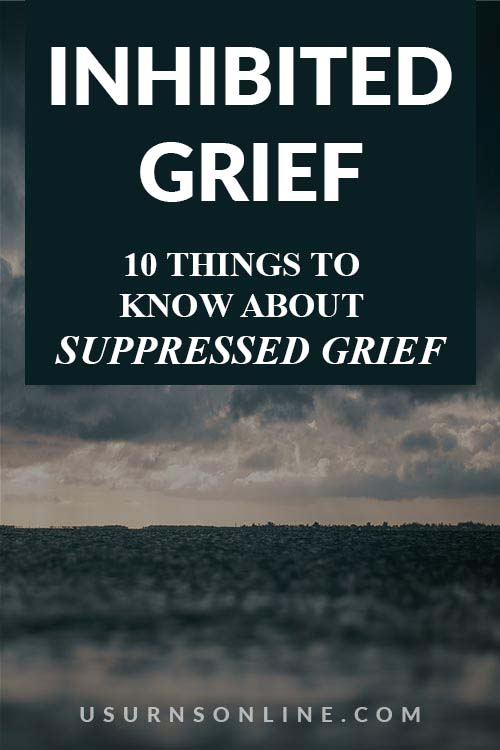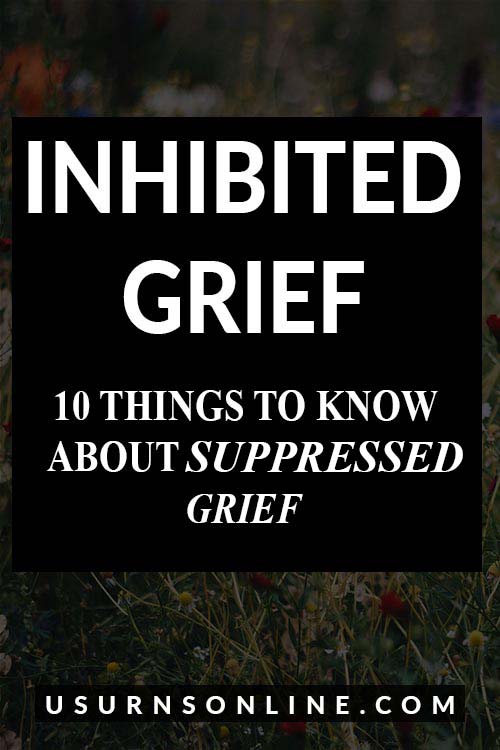Today we’re going to look at inhibited grief.
Grief is a person’s response to a loss. Any loss of something you held importantly can cause a grief reaction. The whirlwind of emotions is a completely normal response to trials, tragedy, and bereavement.
But… Are you trying to avoid your pain and loss? Are you keeping yourself occupied, so you don’t think about your grief? Is your grief discouraged, impeded, restrained, or inhibited?
Read on to find out how your grief may be affecting you and those around you.
What Is Inhibited Grief?
Inhibited grief can appear when you avoid facing your loss. Problems – including emotional and physical issues – can arise if you don’t allow yourself to grieve properly.
You are inhibiting your grief journey when you put your energy into distractions instead of working through the loss. People with inhibited grief often show very few outward signs of mourning, but instead begin to experience physical symptoms that are an outward manifestation of their need to process their loss.

What Are Some Symptoms of Inhibited Grief?
The typical feelings of grief such as guilt, sadness, and anger are multiplied when you add them to the list below.
- Muscle tension
- Insomnia
- Lack of appetite
- Depression
- Anxiety
- Nightmares
- Stomach and digestive problems
Notice how internal these symptoms are? These issues will only worsen as you ignore your grieving. It is important to acknowledge and accept the loss let the healing process begin.
When physical complaints take the place of grief, this is typically the sign of inhibited grief.
What Is the Difference Between Inhibited and Delayed Grief?
Inhibited grief is caused by ignoring your pain and grieving. It happens because you are not willing to face the death of your loved one. Facing reality is too painful. Eventually, if not faced, your grief will cause physical ailments.
Urns Made in the USA
When you restrain your grief, it has nowhere to go. You won’t be able to move beyond it because you’ve suppressed it. And, honestly, this grief has to go somewhere.
Delayed grief is exactly what it says. It is grief that is delayed for one reason or another. Typically, delayed grief can happen if you suffer one loss on top of another. A difficult grieving situation often causes it.
An example of delayed grief would be if your loved one dies, and you lose your job simultaneously.
It is said that your brain plays tricks on you until something happens to trigger you into accepting your loss.
Inhibited grief can exhibit similar signs of delayed grief. The difference between the two is that you are choosing to ignore your loss with inhibited grief.
In delayed grief, you put aside your feelings to deal with another pressing matter. Setting your feelings aside could mean that you have to be the “strong” one. Maybe you are making the funeral arrangements and feel like you don’t have time to grieve yet. Eventually, your delayed grief will catch up with you.
What Is the Difference Between Inhibited and Unresolved Grief?
Unresolved grief is different than most normal forms of grief. It can last much longer and doesn’t lessen with time. In fact, it may become stronger over time. It will interfere with your normal daily life and how you function. Whatever the situation is, the griever tends to hold onto their loved one. In this way, they refuse to accept the loss.
Suffering from unresolved grief can lead to self-destructive behavior. This can lead to suicidal thoughts, reckless and even criminal activity – just to name a few symptoms. Typically, these symptoms don’t occur with someone that is going through inhibited grief.
Now that we know a little more about what it’s not, let’s look more closely at inhibited grief and how to handle it.
10 Things to Know About Inhibited Grief
1. Inhibited grief doesn’t have to be caused by a world-shattering event.
Grief revolves around losing something you love. Your grief may include a death, but it can also include a move, a job loss, or a divorce. Anything that causes changes in your life can make you grieve.
You can go on with your daily life as if nothing is bothering you. People around you may not even know you are going through any life-changing event.
2. Here’s what inhibited grief looks like.
- Pushing emotions away.
- Steering clear of people or situations that will remind you of your grief.
- Staying busier than usual.
- Avoiding the normal grieving process.
3. You will demonstrate physical symptoms.
Your grief will manifest in a physical way instead of an emotional one. Below are a few signs to be aware of.
You might:
- Be more susceptible to illness
- Drink too much
- Neglect your personal hygiene
- Sigh a lot
- Seem fidgety and unable to sit still.
- Eat too much or too little.
After reading this short list, you will see that not all symptoms cause ailments.
4. You may have grown up this way.
In some families, it is a sign of weakness to cry or show emotions. If a person has grown up like this, they are more prone to hold in their emotions. You find it too hard to let sorrow and grief come to the surface.
5. Do you have unresolved issues with the deceased?
Unresolved issues between you and the deceased may cause inhibited grief. There may be guilt, anger, or negative emotions that have not been dealt with.
You might feel it is improper to talk about these problems now that the person is deceased. You may feel, “What good would it do?”
It will do you good to talk! Release these negative feelings and begin your healing journey. Here are some resources on grief counseling.
6. Traumatic loss can inhibit your grief.
If the one you loved suffered a traumatic death, you might feel that it may be too much for you to share. Perhaps it is too graphic to discuss with friends and family. So instead of talking and mourning, you clam up.
You might feel that others couldn’t handle the intensity of your feelings. So, consciously or not, you decide it is best not to mention anything about it instead.
Traumatic grief is difficult enough. Don’t compound it by leaving it unresolved. Find someone you trust (or can work towards trusting) to talk to, acknowledge the loss, and let yourself grieve.
7. Start grieving with small steps.
You may need encouragement to face reminders of your grief. Visit your loved one’s grave. Sort through your loved one’s belongings. Go through old photographs. Bring your emotions to the forefront and face your grief.
Related: How to Let Go of (or Hold Onto) a Loved One’s Belongings
8. You are not alone.
It is so easy for a grieving person to think, “I am the only one going through this; no one can understand.” This line of thought is simply not true.
Grief is a universal emotion. We have all gone through grief at some point in our lives. No, we don’t all grieve the same. And yet, we all have an understanding of bereavement.
It would help you if you realized that grief is experienced throughout the whole world. Many authors and musicians have written books and music to help themselves deal with grief. Many works of art, music, literature, and movies express grief in ways you can relate to.
As you recognize that you are not alone, you open the door for healing to begin.
9. There is no timeline for inhibited grief.
Grief comes in stages that you need to work through. It will help if you accept your grief. Once you accept it, you can start to work through the stages. Don’t try to run or hide from your grief. It would be best if you experienced the pain and anguish so that you can begin to move forward.
Once you have a break-through with your grief – once the inhibition starts to unravel – understand that the real work is just beginning. Don’t allow yourself to revert to your old ways. Keep pushing through. You will see the light at the end of the tunnel. You can attain recovery.
Related: How Long Does Grief Last? A Grief Timeline You Can(‘t) Ignore
10. Here’s how to deal with inhibited grief.
- Talk to someone, anyone, about your grief. It’s not shameful to need to get in touch with a counselor.
- Acknowledge your loss. It’s real. It hurts.
- Journaling is a great way to get your feelings out.
- Stick with your routine.
- Exercise and eat healthy.
- Seek counseling (yes, this is listed twice).
Moving forward from your grief is important so that you can begin to heal. You’ll never forget, and the pang of loss will always be there to some extent, but you can move forward, grow, and learn to live again.
Other Types of Grief
Yes, there are more types of grief than inhibited or unresolved grief. Read the list below to learn more about the different types of grief.
- Abbreviated Grief
- Absent Grief
- Anticipatory Grief
- Chronic Grief
- Collective Grief
- Cumulative Grief
- Complicated Grief
- Delayed Grief
- Disenfranchised Grief
- Distorted Grief
- Exaggerated Grief
- Masked Grief
- Normal Grief
If you or someone you know are stuck in the cycle of (unacknowledged) grief, please find help. You really can begin to enjoy life once more, even as you come to terms with your great loss.
Read Next: The 5 Stages of Grief
Pin It




